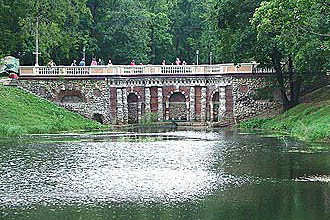 |
 This park in the east of Moscow on the banks of the Yauza River has a rich history, and is claimed as the forerunner of the great Imperial parks around St. Petersburg. Sadly, however, the park has been much neglected, the grandest of its palaces is closed to the public, and current restoration efforts are bogged down in controversy. Nonetheless, the park is worth visiting if you have the time, as there are a number of other interesting sights in the surroundings, a region which was, from the days of Ivan the Terrible, home to Moscow's "expat" community, and under the Soviets became predominantly associated with the security services (the infamous Lefortovo Prison was the remand prison for the KGB's "political" prisoners).
This park in the east of Moscow on the banks of the Yauza River has a rich history, and is claimed as the forerunner of the great Imperial parks around St. Petersburg. Sadly, however, the park has been much neglected, the grandest of its palaces is closed to the public, and current restoration efforts are bogged down in controversy. Nonetheless, the park is worth visiting if you have the time, as there are a number of other interesting sights in the surroundings, a region which was, from the days of Ivan the Terrible, home to Moscow's "expat" community, and under the Soviets became predominantly associated with the security services (the infamous Lefortovo Prison was the remand prison for the KGB's "political" prisoners).
The Franz Lefort who gave his name to the park, the prison and the surrounding area, was a Geneva-born soldier, adventurer and bon viveur, who became a general in Peter's army, an admiral in his navy, and one of the young Tsar's closest companions. Lefort's house in the German Suburb was the site of considerable debauchery involving Peter and his coterie, and in 1697 the Tsar decided to build a palace for his favorite. It was completed in 1699, either just before or just after Lefort's death, so Peter gave the building to Lefort's replacement in his favors, Danylich Menshikov. Menshikov had a new facade added to the Palace in 1708, and the building is unaltered to this day. It is not, however, particularly impressive, and hardly worthy of the "palace" title bestowed on it. It has, appropriately, housed an archive of military history since 1819, and is not open to the public.
The park itself is on the opposite banks of the Yauza, and was originally laid out in 1701 by Feodr Galovin, another of Peter's military commanders, whose estate and palace became another of the Tsar's residences in Moscow. The park was further developed by Empresses Anna Ivanovna and Elizaveta Petrovna, who added their own short-lived palaces, plus follies and landscape features, some of which have survived to this day. The palace that now stands at the opposite end of the park was built for Ekaterina II (Catherine the Great) by three architects, Quarenghi, Rinaldi, and Camporesi. At the same time, the park was significantly remodeled, in part by the Italian-born St Petersburg master, Bartolomeo Rastrelli. The Catherine Palace was completed in 1776, and was the largest building in Moscow in the 18th century. To this day it still has the longest colonnades in the city. It has been military property since the accession of Catherine's son, Paul, and is now home to the Malinovsky Tank Academy.
In the far eastern corner of the park stands the Peter and Paul Church. The wooden original was built on Peter's instructions in 1711 specifically for the soldiers of Lefortov's Regiment, and remodeled in stone 70 years later. Another of Peter's projects for his soldiers was a military hospital, built under the aegis of his chief physician, the Dutchman Nikolai Bidloo. Its current incarnation dates from 1798, and lies a little further away from the park, down Gospitalnaya Ulitsa.
Getting there: 10 minutes' walk from Aviamotornaya Metro Station.
|
 |

 This park in the east of Moscow on the banks of the Yauza River has a rich history, and is claimed as the forerunner of the great Imperial parks around St. Petersburg. Sadly, however, the park has been much neglected, the grandest of its palaces is closed to the public, and current restoration efforts are bogged down in controversy. Nonetheless, the park is worth visiting if you have the time, as there are a number of other interesting sights in the surroundings, a region which was, from the days of Ivan the Terrible, home to Moscow's "expat" community, and under the Soviets became predominantly associated with the security services (the infamous Lefortovo Prison was the remand prison for the KGB's "political" prisoners).
This park in the east of Moscow on the banks of the Yauza River has a rich history, and is claimed as the forerunner of the great Imperial parks around St. Petersburg. Sadly, however, the park has been much neglected, the grandest of its palaces is closed to the public, and current restoration efforts are bogged down in controversy. Nonetheless, the park is worth visiting if you have the time, as there are a number of other interesting sights in the surroundings, a region which was, from the days of Ivan the Terrible, home to Moscow's "expat" community, and under the Soviets became predominantly associated with the security services (the infamous Lefortovo Prison was the remand prison for the KGB's "political" prisoners).